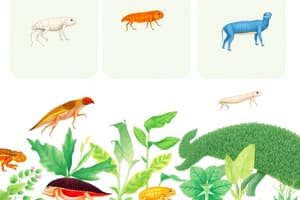Podcast
Questions and Answers
What is the smallest unit of life?
What is the smallest unit of life?
- Tissue
- Organism
- Cell (correct)
- Organ
Which of the following is NOT a characteristic of life?
Which of the following is NOT a characteristic of life?
- The ability to maintain a constant internal environment
- The ability to reproduce and develop
- The ability to respond to stimuli
- The ability to create its own energy (correct)
What is the process by which a population changes over time in response to its environment?
What is the process by which a population changes over time in response to its environment?
- Reproduction
- Homeostasis
- Taxonomy
- Evolution (correct)
Which of the following is NOT a domain of life?
Which of the following is NOT a domain of life?
What is the name of the system used to classify organisms based on their characteristics?
What is the name of the system used to classify organisms based on their characteristics?
Which of the following is NOT a level of classification used in taxonomy?
Which of the following is NOT a level of classification used in taxonomy?
What is the scientific name for humans?
What is the scientific name for humans?
What is the first step in the scientific method?
What is the first step in the scientific method?
What is the purpose of a control group in an experiment?
What is the purpose of a control group in an experiment?
What is the primary characteristic of climate change that makes it distinct from natural climate variations?
What is the primary characteristic of climate change that makes it distinct from natural climate variations?
Flashcards
Characteristics of Life
Characteristics of Life
Common traits shared by all living organisms.
Life is Organized
Life is Organized
Organisms are arranged in a hierarchy, smallest unit being cells.
Energy Requirement
Energy Requirement
Organisms need energy and materials from the environment.
Reproduction and Development
Reproduction and Development
Signup and view all the flashcards
Homeostasis
Homeostasis
Signup and view all the flashcards
Taxonomy
Taxonomy
Signup and view all the flashcards
Eukarya
Eukarya
Signup and view all the flashcards
Scientific Method
Scientific Method
Signup and view all the flashcards
Hypothesis
Hypothesis
Signup and view all the flashcards
Experimental Design
Experimental Design
Signup and view all the flashcards
Model Organisms
Model Organisms
Signup and view all the flashcards
Statistical Significance
Statistical Significance
Signup and view all the flashcards
Scientific Theory
Scientific Theory
Signup and view all the flashcards
Placebo
Placebo
Signup and view all the flashcards
Climate Change
Climate Change
Signup and view all the flashcards
Data Presentation
Data Presentation
Signup and view all the flashcards
Study Notes
Characteristics of Life
- Life is organized in a hierarchy, with cells as the smallest unit.
- Organisms need materials and energy to maintain organization.
- Life reproduces and develops, creating similar organisms.
- Living things respond to their environment.
- Maintaining internal balance (homeostasis) is crucial for life.
- Living things adapt over time through evolution.
Classification of Life
- Taxonomy groups and organizes organisms.
- Systematics studies evolutionary relationships between species.
- Life is divided into three domains: Archaea, Bacteria, and Eukarya.
- Eukarya includes four kingdoms: protists, fungi, plants, and animals.
- Organisms have specific names; genus followed by species (e.g., Homo sapiens).
- Additional categories exist (phylum, class, order, family, genus, species).
The Scientific Method
- Science involves an objective approach to understanding the natural world.
- Scientists use a standard process (scientific method).
- Observations are crucial for understanding phenomena.
- A hypothesis explains the observed phenomenon.
- Predictions and experiments are used to test hypotheses
- Data is collected and analyzed using statistics.
- Scientific theories are accepted explanations.
- Variables must be controlled during experiments.
Science and Society
- Technology applies scientific knowledge to human needs.
- Science is the basis for technology.
- Climate change is an example of global concerns based on scientific investigation.
- Biodiversity loss and habitat destruction are results of human activity.
- Emerging and reemerging diseases are significant health issues, impacting globally.
Studying That Suits You
Use AI to generate personalized quizzes and flashcards to suit your learning preferences.




